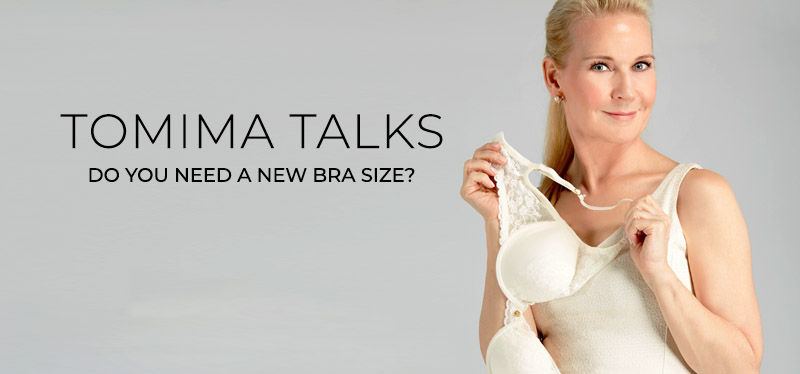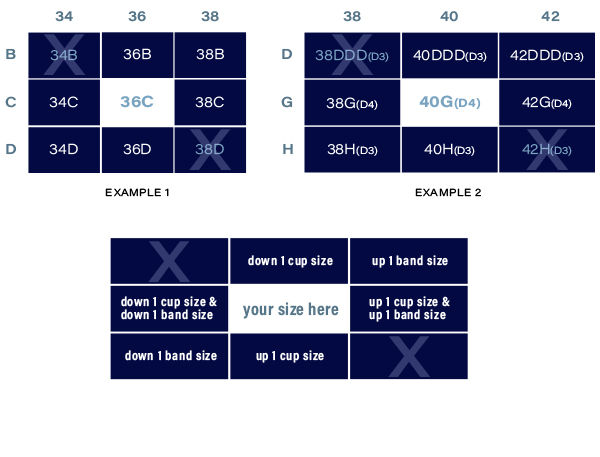Tomima Talks: Do You Need A New Bra Size?
- clinton6145
- Jan 14, 2021
- 4 min read

Many of you have asked for help in finding a new bra size. And many of you have left product reviews claiming the manufacturer of your favorite bra has strangely made your size much smaller.
Changing your bra size should be simple and intuitive. Unfortunately, it’s neither. So, here’s a quick tutorial.
Changing your Band Size
Need a larger band size?
If the hooks on your newest bra are on their loosest setting and it feels tight, you need a larger band size. But you can’t just move up to a larger band size without also modifying your cup letter size. When you move up a band size, you must also move down a cup size to keep the same cup volume. If you don’t change your cup size, your cups in the larger band size will be too large.
Example: 38D should move to a 40C if wanting just a larger band size.
Need a smaller band size?
Hook on your newest bra on its tightest setting and raise your arms over your head. If your band moved up your torso, you need a smaller band size. But here is where mistakes happen. When you go down a band size you also need to go up a cup size to maintain your same cup volume. If you don’t change your cup size, your cups in your new and smaller band size will be too small.
Example: 38D should move to a 36DD (D2) if wanting just a smaller band size.
For a more in-depth explanation on band sizing, click here.
Need a larger cup size?
Breast tissue spillage along the edges of your cups and/or your center panel not resting on your sternum are signs your cups are too small. Each cup size increase represents a 1-inch increase in your bustline circumference. For small-framed women wearing 28 to 36 band sizes, a 1-inch circumference increase makes a difference. Women with 38 and larger band sizes may need to go up more than one cup size because a 1-inch increase around their bustline circumference is not as significant.
Example: 36″ bustline gets 3% more circumference with each cup size increase. versus 46″ bustline only gets 2% more circumference.
Reducing spillage in larger band sizes many times means increasing your cup size by more than one size. You will know you are in the right cup size when your breast tissue is contained, and your bra’s center panel is resting on your sternum. Try to avoid using plunge, wireless, bralettes, and minimizer bras when trying to find a new bra size. Most don’t have a precise fit, and a minimizer bra is not designed to tack in the center.
Once you find your true cup size, it is very likely that your existing band size has become too large. This makes sense because all your breast tissue is now fully in your new roomy cups instead of spilling into your bra band. But remember, as I stated above, if you go down a band size, you will need to go up yet another cup size to maintain the volume of your newfound cup size.
Example: 40DDD(D3) moves up two cup sizes to a 40H(D5). Cups now fit, but band is too big. So… Move down one band size and up another cup size to 38I(D6).
Cups too large?
Wrinkling in the cups is symptomatic of your cups being too large. If you have pulled all your breast tissue into your cups and tightened your straps yet still have wrinkling, you should move down a cup size or two.
For a more in-depth explanation on cup sizing, click here
#1 Bra Size Mistake
Here’s a curious fact. Most women wearing the wrong bra size are wearing a bra too big in the band and too small in the cups. There are a couple of reasons for this.
It wasn’t until the 1990s that bra manufacturers made a cup size larger than a DD(D2). Women with larger breast sizes could only buy a DD cup size, so were going up in band sizing till they found a size that could at least attach in the back. Of course, their fit was terrible.
Most women wearing the wrong size simply don’t know what a well-fitting bra should look like. They think that full breasts sort of spilling out, smashed together in front, or hanging low is the way a bra should fit. Hollywood has not been a stellar example of well-fitting bras.
There is an old stigma out there that any cup size larger than a D means you have enormous breasts. So, many modest women will not go larger in the cup and instead just move up a band size till it attaches.
To see an actual example of a model starting in a 34G(D4) and finding she’s a 30I(D6), watch this short video.
Know Your Sister Bra Sizes
You have probably heard that you have “sister sizes” when it comes to bras. Your sister sizes are a group of bra sizes that surround your current size. If you want to adjust your bra size, chances are you just need to move to one of your sister sizes for a better fit. So, building your own sister size grid will be a terrific aid as you go through any bra size change.
Here are two sister size grid examples – one for 36C and the other for 40G(D4). You start with your current bra size in the middle, then fill in the grid with your sister sizes. After you create your personal sister size grid, block out the upper left and lower right sizes

For a more in-depth explanation of sister sizing, watch this short video
HerRoom is always available to help if you don’t want to figure out your new and better bra size by yourself. Many of you know that the women answering our live chat are experts in the field. And for good reason. They truly are! So are the women answering our phones when you press 3. All have years of fit experience along with having graduated from my HerRoom fit training program. We want you in the right size and the right bra that is best for you. We know how to get you there
Some Final Thoughts…
With a new bra size, it’s always a safe bet to test it out in a long-time tried-&-true bra style. My 20+ years in the lingerie business means I know which bra styles are consistently best sellers with low return rates and high customer ratings. So, here’s the list of bra styles that have stood the test of time. They may not be the prettiest but have been beloved for years. And for those of you pledging to exercise more, here’s the list of best-selling, timeless sports bras too.
Fondly,
Tomima Founder & CEO








